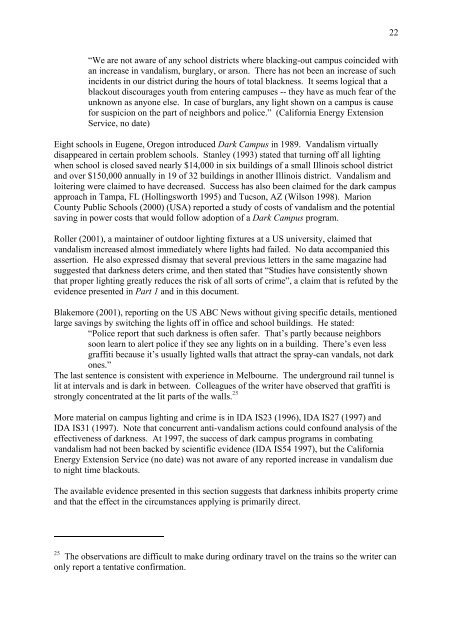Outdoor Lighting and Crime - Amper
Outdoor Lighting and Crime - Amper
Outdoor Lighting and Crime - Amper
Create successful ePaper yourself
Turn your PDF publications into a flip-book with our unique Google optimized e-Paper software.
“We are not aware of any school districts where blacking-out campus coincided with<br />
an increase in v<strong>and</strong>alism, burglary, or arson. There has not been an increase of such<br />
incidents in our district during the hours of total blackness. It seems logical that a<br />
blackout discourages youth from entering campuses -- they have as much fear of the<br />
unknown as anyone else. In case of burglars, any light shown on a campus is cause<br />
for suspicion on the part of neighbors <strong>and</strong> police.” (California Energy Extension<br />
Service, no date)<br />
Eight schools in Eugene, Oregon introduced Dark Campus in 1989. V<strong>and</strong>alism virtually<br />
disappeared in certain problem schools. Stanley (1993) stated that turning off all lighting<br />
when school is closed saved nearly $14,000 in six buildings of a small Illinois school district<br />
<strong>and</strong> over $150,000 annually in 19 of 32 buildings in another Illinois district. V<strong>and</strong>alism <strong>and</strong><br />
loitering were claimed to have decreased. Success has also been claimed for the dark campus<br />
approach in Tampa, FL (Hollingsworth 1995) <strong>and</strong> Tucson, AZ (Wilson 1998). Marion<br />
County Public Schools (2000) (USA) reported a study of costs of v<strong>and</strong>alism <strong>and</strong> the potential<br />
saving in power costs that would follow adoption of a Dark Campus program.<br />
Roller (2001), a maintainer of outdoor lighting fixtures at a US university, claimed that<br />
v<strong>and</strong>alism increased almost immediately where lights had failed. No data accompanied this<br />
assertion. He also expressed dismay that several previous letters in the same magazine had<br />
suggested that darkness deters crime, <strong>and</strong> then stated that “Studies have consistently shown<br />
that proper lighting greatly reduces the risk of all sorts of crime”, a claim that is refuted by the<br />
evidence presented in Part 1 <strong>and</strong> in this document.<br />
Blakemore (2001), reporting on the US ABC News without giving specific details, mentioned<br />
large savings by switching the lights off in office <strong>and</strong> school buildings. He stated:<br />
“Police report that such darkness is often safer. That’s partly because neighbors<br />
soon learn to alert police if they see any lights on in a building. There’s even less<br />
graffiti because it’s usually lighted walls that attract the spray-can v<strong>and</strong>als, not dark<br />
ones.”<br />
The last sentence is consistent with experience in Melbourne. The underground rail tunnel is<br />
lit at intervals <strong>and</strong> is dark in between. Colleagues of the writer have observed that graffiti is<br />
strongly concentrated at the lit parts of the walls. 25<br />
More material on campus lighting <strong>and</strong> crime is in IDA IS23 (1996), IDA IS27 (1997) <strong>and</strong><br />
IDA IS31 (1997). Note that concurrent anti-v<strong>and</strong>alism actions could confound analysis of the<br />
effectiveness of darkness. At 1997, the success of dark campus programs in combating<br />
v<strong>and</strong>alism had not been backed by scientific evidence (IDA IS54 1997), but the California<br />
Energy Extension Service (no date) was not aware of any reported increase in v<strong>and</strong>alism due<br />
to night time blackouts.<br />
The available evidence presented in this section suggests that darkness inhibits property crime<br />
<strong>and</strong> that the effect in the circumstances applying is primarily direct.<br />
25<br />
The observations are difficult to make during ordinary travel on the trains so the writer can<br />
only report a tentative confirmation.<br />
22
















